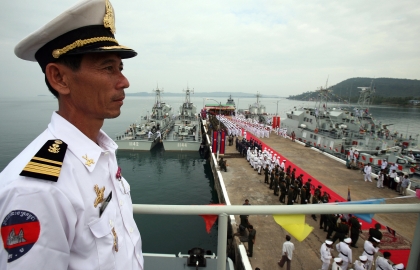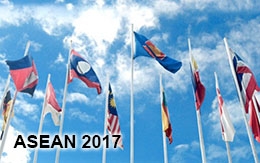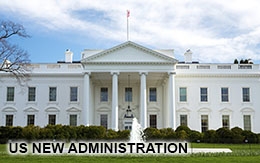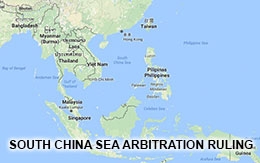Dr Chheang Vannarith is a public policy analyst, government relations strategist and educator. He is the president of the Asian Vision Institute (AVI).
Rising Trend of Maritime Power Projection in Southeast Asia: Perspective from Cambodia
The rising trend of maritime power projection in Southeast Asia has sparked concerns among Southeast Asian countries. As major powers increase their naval presence and influence in the region, it becomes imperative for ASEAN to respond with a more robust collective effort. By acknowledging this trend, ASEAN can work towards developing an effective and collective strategy to address these challenges.
By Chheang Vannarith
November 6, 2023

ASEAN's Response to Maritime Power Projection:
ASEAN has taken significant steps to respond to maritime power projection in and around Southeast Asia. Notable initiatives include the ASEAN Declaration on the Conduct of Parties in the South China Sea (DOC), which encourages dialogue, peaceful resolution, and self-restraint among parties involved in territorial disputes. Efforts are underway to develop a more substantive Code of Conduct (COC) to replace the DOC.
The Code for Unplanned Encounters at Sea (CUES) is another valuable contribution by ASEAN to promote maritime safety and reduce the risk of misunderstandings or accidents. ASEAN's engagement through mechanisms like the ASEAN Regional Forum (ARF) and the ASEAN Defence Ministers Meeting (ADMM) facilitates dialogue, confidence-building measures, and preventive diplomacy.
ASEAN Outlook on the Indo-Pacific (AOIP) outlines ASEAN's vision for the Indo-Pacific region and provides a framework for practical cooperation, including in the realm of maritime security. The AOIP aims to promote ASEAN's centrality in the evolving regional architecture and ensure that ASEAN remains at the forefront of decision-making processes.
The Code for Unplanned Encounters at Sea (CUES) is another valuable contribution by ASEAN to promote maritime safety and reduce the risk of misunderstandings or accidents. ASEAN's engagement through mechanisms like the ASEAN Regional Forum (ARF) and the ASEAN Defence Ministers Meeting (ADMM) facilitates dialogue, confidence-building measures, and preventive diplomacy.
ASEAN Outlook on the Indo-Pacific (AOIP) outlines ASEAN's vision for the Indo-Pacific region and provides a framework for practical cooperation, including in the realm of maritime security. The AOIP aims to promote ASEAN's centrality in the evolving regional architecture and ensure that ASEAN remains at the forefront of decision-making processes.
ASEAN's Role in the Region's Maritime Balance of Power:
ASEAN's role in the region's maritime balance of power should be multifaceted, reflecting its commitment to peace, stability, and cooperation. First, ASEAN must actively engage in efforts to maintain regional stability and security. By fostering dialogue, building trust, and promoting cooperation among member states and external powers, ASEAN can contribute to preventing conflicts and escalating tensions especially between major powers.
Second, ASEAN should advocate for a rules-based order and the adherence to international law, particularly the United Nations Convention on the Law of the Sea (UNCLOS). ASEAN's active promotion and strengthening of multilateral mechanisms, such as UNCLOS, will foster fair and equitable maritime environments and contribute to the peaceful resolution of disputes.
Second, ASEAN should advocate for a rules-based order and the adherence to international law, particularly the United Nations Convention on the Law of the Sea (UNCLOS). ASEAN's active promotion and strengthening of multilateral mechanisms, such as UNCLOS, will foster fair and equitable maritime environments and contribute to the peaceful resolution of disputes.
Third, ASEAN should facilitate capacity-building initiatives and cooperative efforts among member states. By sharing best practices, conducting joint exercises and patrols, and addressing non-traditional security challenges, ASEAN can enhance the collective ability to ensure a balanced and secure maritime environment.
Fourth, engaging with external powers involved in the region's maritime affairs is crucial. ASEAN can provide a platform for dialogue, confidence-building measures, and cooperative initiatives. Ensuring that external powers respect and consider the interests and concerns of ASEAN member states is vital for regional stability and security.
Fifth, ASEAN should strike a delicate balance between taking an active role in the region's maritime balance of power and maintaining its neutrality and non-alignment principles. By fostering an inclusive and cooperative regional architecture, ASEAN can accommodate the interests of all stakeholders and prevent being drawn into major power rivalries.
Lastly, ASEAN must exercise caution and closely monitor the potential expansion of the North Atlantic Treaty Organization (NATO) into the Indo-Pacific region. While NATO has been a key security alliance in the Euro-Atlantic region, its expansion into the Indo-Pacific could have implications that may complicate or undermine regional security and stability.
To conclude here, as the trend of maritime power projection continues to shape the Indo- Pacific, ASEAN must strengthen its collective response. By recognizing the perception of rising maritime power projection, leveraging existing initiatives, and embracing its role in the region's maritime balance of power, ASEAN can contribute to peace, stability, and prosperity in Southeast Asia. It is imperative for ASEAN to maintain its commitment to a rules-based order, foster dialogue, build trust, and engage with external powers to safeguard the region's maritime security for the benefit of all.
Comments (0)
Same category
© 2016 Maritime Issues










